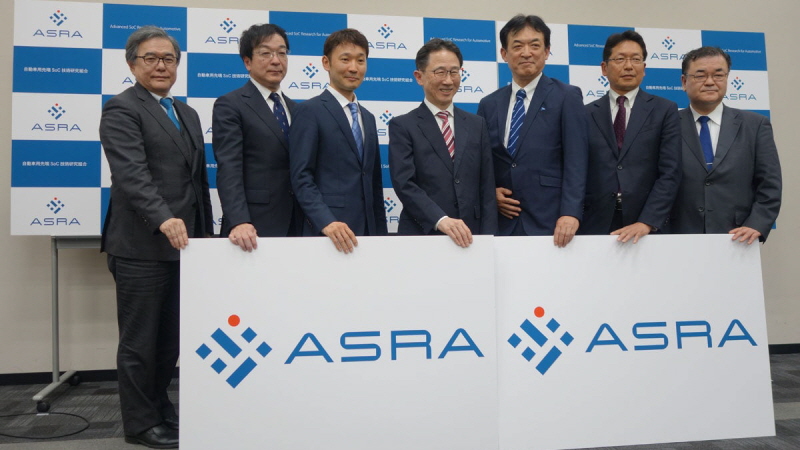일본 자동차용 첨단 SoC 기술연구조합(이하 ASRA)은 지난 3월29일 신에너지·산업기술종합개발기구(이하 NEDO)로부터 ‘첨단 SoC 칩렛의 연구 개발’의 위탁처로 채택되며 자동차 칩렛의 2025년도 이후에 개발을 본격화할 것이라는 계획을 발표했다.

▲ASRA 이사진. 왼쪽부터 카토 료분 미라이즈 테크놀로지스 이사, 미즈야마 마사시게 파나소닉 오토모티브 시스템즈 부사장, 요 쇼 마토 씨 혼다 총괄 부장, 야마모토 케이지 이사장, 카와하라 신장 전무 이사(덴소 시니어 어드바이저), 요시자와 타카시씨 닛산 자동차 상무 집행 임원, 요시오카 마이치씨 르네사스 일렉트로닉스 집행 임원(사진 출처: My Navi)
2025년도 이후 개발 본격화 후 2028년 제품 레벨 검증 완료 계획
칩렛 차재 적용 예시 없어…신뢰성 중심 각종 성능 확인 작업 必
일본이 차량용 SoC에 칩렛 기술을 적용하기 위한 개발을 본격화한다.
일본 자동차용 첨단 SoC 기술연구조합(이하 ASRA)은 지난 3월29일 신에너지·산업기술종합개발기구(이하 NEDO)로부터 ‘첨단 SoC 칩렛의 연구 개발’의 위탁처로 채택되며 자동차 칩렛의 2025년도 이후에 개발을 본격화할 것이라는 계획을 발표했다.
ASRA는 칩렛 기술을 차재 SoC에 적용하기 위해 2024년도 중 차재 시스템 아키텍처의 요건 정의, 차재 특유의 요건의 명확화, 칩렛 SoC의 요건 정의로서 HW/SW 요구사항 정의 및 아키텍처 검증 등을 진행하여 2024년 내 요건 및 목표치의 설정, 상세 개발 계획을 확실시하는 것을 목표로 하고 있다.
이어 2025년도 이후에 개발을 본격화하는 것으로 입을 모았으며, 우선 데이터 센터용 칩렛 기술을 베이스로 프로토타입 칩을 제작, 평가를 실시해 차재용으로 부족한 성능 및 기능을 파악해 이를 보완하는 기술을 개발할 것으로 보인다.
최종적으로 2028년도를 목표로 차재 시스템 아키텍처의 요건을 완성, 칩렛 SoC 요건에 근거하는 설계 툴·환경 개발의 정비, 칩렛 SoC 그 자체의 제품 레벨 검증을 끝낼 것을 계획하고 있다.
구체적으로는 멀티 코어와 같이 동일 칩렛의 병렬 배치에 의한 스케일러블한 성능 변경을 가능하게 하는 기술의 구축을 목표로 한다.
개발하는 칩렛의 베이스가 되는 규격은 UCIe에 준거한다고 하고 있지만, 실제의 CPU나 GPU등은 각 자동차 제조사마다 요구하는 성능 등이 다르기 때문에 ASRA에서는 칩렛 기술의 사양 책정, 각 프로세서 코어의 소자 등은 각 자동차 메이커의 경쟁 영역이라 전했다.
또한 칩렛을 차재에 적용한 예는 지금까지 없었고, 신뢰성을 중심으로 자동차로 요구되는 각종 성능 등을 확인해 나가는 작업이 필요하다는 데도 입을 모았다.
NEDO의 보조금은 2024년도 성과를 달성할 경우 10억엔이 지급될 것으로 보이며 매년마다 성과를 근거로 다음 해의 보조금액이 정해지는 것으로 파악되고 있다.
연구 개발 체제는 자동차 메이커의 엔지니어가 중심이 되는 ‘차량 시스템 아키텍처 워킹 그룹’, 티어1 메이커의 엔지니어가 중심이 되는 ‘SoC 아키텍처 워킹 그룹’과 반도체 관련 메이커의 엔지니어로 구성된다.
ASRA 내부 130명, 3개 규모 칩렛 기술 워킹 그룹이 조직되었으며 외부의 기업이나 기관 등과도 제휴를 통해 국제 표준화나 웨이퍼의 프로토타입, 패키지의 조립 등을 진행해 나가고 있다.
한편 ASRA는 자동차의 한층 더 지능화·전동화를 실현하는 차재 HPC의 실현을 향한 칩렛 기술의 연구 개발을 목적으로 2023년 12월 1일에 설립된 기술 연구 조합이다.
스즈키, 히타치 Astemo가 3월28일자로 새롭게 ASRA에 참여했으며, 이로 인해 ASRA의 총 참가 기업은 14사가 되었다.
이외 ASRA 소속 기업으로는 자동차 제조사인 △토요타 자동차 △SUBARU △닛산 자동차 △혼다 △마쓰다, 전장 부품 메이커인 △덴소 △파나소닉 오토모티브 시스템, 반도체 관련 메이커 △소시오넥스트 △일본 케이던스·디자인·시스템즈 △일본 시놉시스 △미라이즈 테크놀로지즈 △르네사스 일렉트로닉스가 있다.
